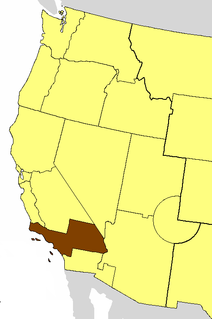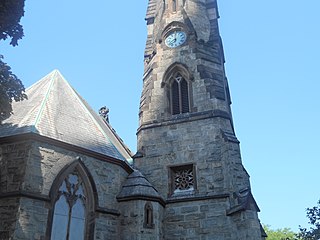Related Research Articles

Pyrus pyrifolia is a species of pear tree native to East Asia. The tree's edible fruit is known by many names, including: Asian pear, Japanese pear, Chinese pear, Korean pear, Taiwanese pear, apple pear, zodiac pear, three-halves pear, papple and sand pear. Along with cultivars of P. × bretschneideri and P. ussuriensis, the fruit is also called the nashi pear. Cultivars derived from Pyrus pyrifolia are grown throughout East Asia, and in other countries such as India, Australia, New Zealand, and the United States. Traditionally in East Asia the tree's flowers are a popular symbol of early spring, and it is a common sight in gardens and the countryside.

The Episcopal Diocese of Washington is a diocese of the Episcopal Church covering Washington, D.C. and nearby counties of Maryland in the United States. With a membership of over 38,000, the diocese is led by the Bishop of Washington, Mariann Budde. It is home to Washington National Cathedral, which is the seat of both the diocesan bishop and the Presiding Bishop of the Episcopal Church.

Francis Lister Hawks was an American writer, historian, educator and priest of the Episcopal Church. After practicing law with some distinction, Hawks became an Episcopal priest in 1827 and proved a brilliant and impressive preacher, holding livings in New Haven, Philadelphia, New York City and New Orleans, and declining several bishoprics. However, scandals during the 1830s and 40s led him to posts on the American frontier and rejection of his selection as bishop of Mississippi, although Hawks then became the first president of the University of Louisiana, then moved to Baltimore, Maryland, and eventually returned to New York City.

The Episcopal Diocese of Los Angeles is a community of 48,874 Episcopalians in 147 congregations, 40 schools, and 18 major institutions, spanning all of Los Angeles, Orange, San Bernardino, Santa Barbara, and Ventura counties, and part of Riverside County.

The Episcopal Diocese of Louisiana is the diocese of the Episcopal Church in the eastern part of the state of Louisiana. The see city is New Orleans.

The Episcopal Diocese of Eau Claire is a diocese of the Episcopal Church in the United States of America encompassing the northwestern third of Wisconsin. It is part of Province 5. The diocese comprises 20 interdependent congregations, mostly small and rural. The see and diocesan offices are in Eau Claire, Wisconsin, with Christ Church Cathedral as the mother church. Christ Church in La Crosse is the largest church in the diocese.

The Episcopal Diocese of New York is a diocese of the Episcopal Church in the United States of America, encompassing the boroughs of Manhattan, the Bronx, and Staten Island in New York City, and the New York state counties of Westchester, Rockland, Dutchess, Orange, Putnam, Sullivan, and Ulster.

The Episcopal Diocese of Bethlehem covers fourteen counties in Pennsylvania to the north and west of Philadelphia. The current bishop, the Rt. Rev. Kevin D. Nichols, was elected as Bishop on April 28, 2018, and consecrated on September 15, 2018. The cathedral is the Cathedral Church of the Nativity in Bethlehem. The pro-Cathedral is St. Stephen's, Wilkes-Barre.

The Episcopal Diocese of Iowa is the diocese of the Episcopal Church in the United States of America which covers all of Iowa. It is in Province VI. Its offices are in Des Moines, and it has two cathedrals: the Cathedral Church of St. Paul in Des Moines and Trinity Cathedral in Davenport.

Charles Todd Quintard was an American physician and clergyman who became the second bishop of the Episcopal Diocese of Tennessee and the first Vice-Chancellor of the University of the South.

The Episcopal Diocese of Indianapolis, formerly known as the Episcopal Diocese of Indiana, is a diocese in Province V of the Episcopal Church. It encompasses the southern two-thirds of the state of Indiana. Its see is in Indianapolis, Indiana, at Christ Church Cathedral. According to the diocesan newsletter, the diocese has 10,137 communicants in 49 parishes. The current bishop is Jennifer Baskerville-Burrows, the first African-American woman to serve as diocesan bishop in the Episcopal Church and the first woman to succeed another woman as a diocesan bishop in the Episcopal Church; Catherine Waynick served as bishop of the diocese from 1997 to 2017.

Alfred Lee was an American Episcopal bishop. He was born in Cambridge, Massachusetts, graduated from Harvard in 1827, and after three years practicing law in New London, Connecticut, he studied for the ministry, graduating from the General Theological Seminary, New York, in 1837. He was rector of Calvary Church, in Rockdale, Pa., from 1838 to 1841, when he was chosen as the first Bishop of Delaware. In 1842 he also became rector of St. Andrew's, Wilmington. He was a member of the American Committee for the Revision of the New Testament (1881). In 1884 he succeeded Bishop Smith as presiding bishop of the Episcopal church.

Trinity-St. Paul's Episcopal Church in New Rochelle in Westchester County, New York was added to the National Register of Historic Places in 2006. It is located at the northwest corner of Huguenot Street and Division Street. This church represents the body of the majority group of New Rochelle's founding Huguenot French Calvinistic congregation that conformed to the liturgy of the established Church of England in June 1709. King George III gave Trinity its first charter in 1762. After the American Revolutionary War, Trinity became a parish of the Protestant Episcopal Church of America.

The Episcopal Diocese of Alaska is the diocese of the Episcopal Church in the United States of America with jurisdiction over the state of Alaska. Established in 1895, it has the largest geographical reach of any diocese in the Episcopal Church, with approximately 7,000 members spread across 53 congregations. It is in Province 8. It has no cathedral and the diocesan offices are located in Fairbanks.

The Episcopal Church (TEC), based in the United States with additional dioceses elsewhere, is a member church of the worldwide Anglican Communion. It is a mainline Christian denomination and is divided into nine provinces. The presiding bishop of the Episcopal Church is Michael Bruce Curry, the first African-American bishop to serve in that position.
The Lawton blackberry originated in the village of New Rochelle in New York, and was the first widely cultivated variety of blackberry in the United States. It was either an accidental seedling from a wild variety of blackberry, or possibly a sort accidentally brought to this country by the French Huguenots who settled New Rochelle in 1688. The fruit-bearing bush is from the genus Rubus, in the rose family, and bears large berries that grow to about an inch long.
The Churchland or Church is a cultivar of the European pear, it was developed in New Rochelle, New York in northeastern United States. It is believed to have originated as a seedling raised by one of the early Huguenot settlers of the village in the late 17th century. The original tree stood on land which was owned by the Trinity St. Paul's Church of New Rochelle, hence the naming of the fruit "Church". The fruit was so luscious that it was universally liked and, by grafting, the tree soon had extensive propagation throughout the country. An early account of the tree appeared in the proceedings of the American Pomological Society in 1856.
The Huntington is a cultivar of the European Pear and is a native of New Rochelle, New York in northeastern United States. The original pear tree was found in the woods by James P. Huntington when still small and was transplanted to his yard on Main Street in the center of town. In 1856, when the tree was about 20 years of age, it was introduced by Stephen P. Carpenter of the Huguenot Nurseries of New Rochelle.

John B. Sutcliffe was an Anglo-American architect.
The Episcopal Diocese of South Carolina was established in 1785 as one of the nine original dioceses of the Episcopal Church in the United States. The diocese originally covered the entire state of South Carolina, but the western part of the state became the Episcopal Diocese of Upper South Carolina in 1922. In 2012, a controversy led to the existence of two rival dioceses, the Anglican Diocese of South Carolina and the Episcopal Church in South Carolina, each claiming to be the legitimate successor of the original diocese.
References
- ↑ Downing, A.J. (1853). The Horticulturist, And Journal Of Rural Art And Rural Taste. James Vice Jr.
- ↑ Convention of Episcopal Church, Diocese of New York Journal of the Proceedings of the 91st Annual Convention of the Protestant Episcopal Church in the Diocese of New York, Issues 91-93 (1874) , p. 186, at Google Books
- ↑ Nichols, Herbert B. (1938). Historic New Rochelle. The Board of Education, New Rochelle. pp. 84.
- ↑ Downing, A.J. (1853). The Horticulturist, And Journal Of Rural Art And Rural Taste. James Vice Jr.

